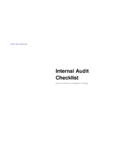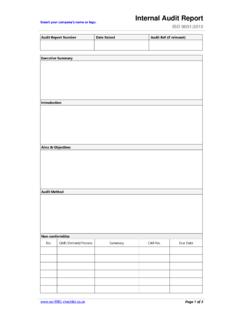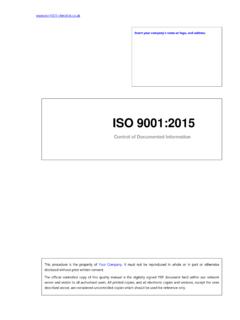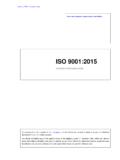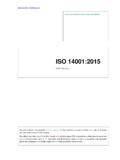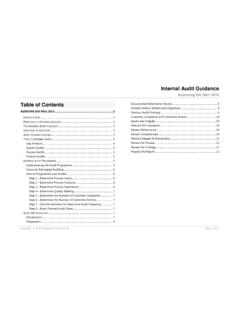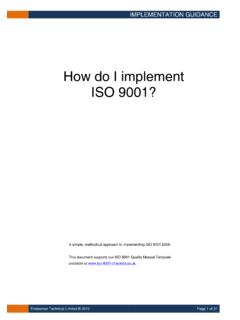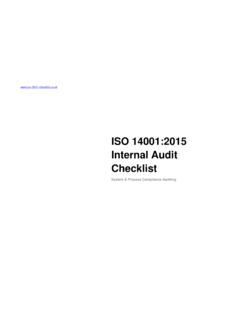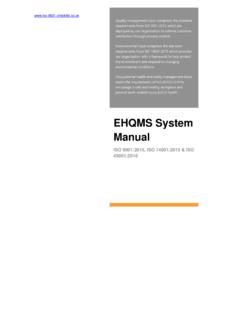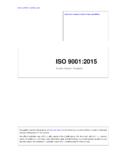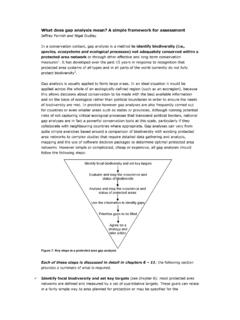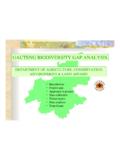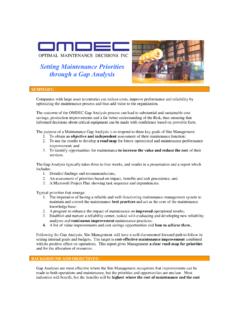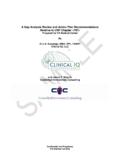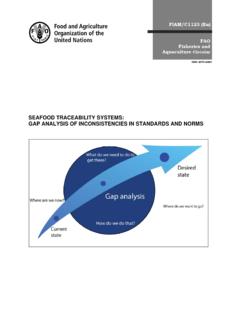Transcription of Gap Analysis Checklist
1 Gap Analysis Checklist ISO 9001:2015 Self-assessment Insert your company s name or logo. Gap Analysis Checklist ISO 9001:2015 Self-assessment Page 1 of 17 Contents Guidance _____ 2 About this Checklist _____ 2 Summary of Key Changes _____ 2 Process Approach _____ 2 Context of the Organization _____ 2 Scope of the Quality Management System _____ 3 Leadership _____ 3 Risks and Opportunities _____ 3 Products and Services _____ 3 Control of Externally Provided Products & Services _____ 3 Documented Information _____ 3 Non-conforming Processes _____ 4 How to Make the Changes _____ 4 Existing ISO 9001.
2 2008 Documentation _____ 4 Self-assessment Checklist _____ 6 Context of the Organisation _____ 6 Leadership _____ 8 Planning _____ 10 Support_____ 11 Operation _____ 13 Performance Evaluation _____ 16 Improvement _____ 17 Insert your company s name or logo. Gap Analysis Checklist ISO 9001:2015 Self-assessment Page 2 of 17 Guidance About this Checklist This gap Analysis Checklist highlights the new requirements contained in ISO 9001:2015, and is not intended to cover all of the requirements from ISO 9001:2015 comprehensively.
3 The unique knowledge obtained about the status your existing quality management system will be a key driver of the subsequent implementation approach. Armed with this knowledge, it allows you to establish accurate budgets, timelines and expectations which are proportional to the state of your current management system when directly compared to the requirements of the standards. Your organization may already have in place an ISO 9001:2008 compliant quality management system or you might be running an uncertified system. If this is the case, you will want to determine how closely your system conforms to the requirements ISO 9001:2015.
4 The results of a gap Analysis exercise will help to determine the differences, or gaps, between your existing management system and the new requirements. Not only will this Analysis template help you to identify the gaps, it will also allow you to recommend how those gaps should be filled. The gap Analysis output provides a valuable baseline for the implementation process as a whole and for measuring progress. Try to understand each business process in the context of each of the requirements by comparing different activities and processes with what the standard requires.
5 At the end of this activity you will have a list of activities and processes that comply and ones that do not comply. The latter list now becomes the target of your implementation plan. Summary of Key Changes Process Approach The process approach was promoted by ISO 9001:2008 and is now a requirement in its own right, which sets out the specific requirements for the adoption of a process approach. Context of the Organization A new clause and sub clauses are being introduced relating to the context of the organization. Your organization is now required to identify and asses all internal and external issues that could impact upon your quality management system s ability to deliver its intended results.
6 You will need to develop a methodology to understand the needs and expectations of all interested parties. Insert your company s name or logo. Gap Analysis Checklist ISO 9001:2015 Self-assessment Page 4 of 17 Non-conforming Processes The Control of non-conforming products now includes non-conforming processes. Your organization is now required to evaluate whether a process is not conforming to planned arrangements and, where necessary, investigate the cause and take action to prevent recurrence. How to Make the Changes Purchase copies of ISO 9000:2015 and ISO 9001:2015.
7 Read them both and make yourself familiar with their language and concepts. Although it is written in a dense, formal language, the clause titles in ISO 9001:2015 are fairly self-explanatory. We suggest that you use the familiar Plan-Do-Check-Act (PDCA) methodology to manage your organization s transition from the old to the new requirements. The following guidance provides nine simple steps to make the transition, using the PDCA approach: 1. Plan: Undertake a gap Analysis to understand how the requirements affect your QMS and then prepare the transition plan based on the results.
8 2. Do: Implement the transition plan by ensuring that the new requirements are embedded in to your QMS and your processes. 3. Check: Evaluate the effectiveness of the newly implemented aspects by performing a full system (element) audit, review the findings and implement any corrective actions. 4. Act: Take action to address transition any problems and improve the QMS before beginning process auditing. Existing ISO 9001:2008 Documentation The extent of the documented information will differ from your organization to another because of to the size of organization and its activities, processes, products and services; the complexity of processes and their interactions, and the competence of personnel.
9 In ISO 9001:2008, the quality manual helped to establish and document the framework of your organization's quality management system while articulating those aspects of the QMS to any interested parties. While there is no requirement for a quality manual or any documented procedures in ISO 9001:2015, it is suggested that if they add value, then they should not simply be binned. You will be expected to maintain the integrity of the QMS during the transition process. You do not need to renumber your existing Insert your company s name or logo.
10 Gap Analysis Checklist ISO 9001:2015 Self-assessment Page 6 of 17 Self-assessment Checklist Context of the Organisation Ref Gap Analysis Question Finding Implementation Plan (if No) Yes No ISO Clause Process Owner Action Needed Date Planned Date Actual 1 Have all external and internal issues that are relevant to your organisation s purpose and the achievement of customer satisfaction and the organisation s strategic direction been determined? 2 Are these issues reviewed and monitored on a regular basis? 3 Have the needs and expectations of interested parties that are relevant to the QMS been determined?
